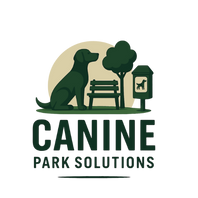How to Design Your Dog Park
A Step-by-Step Guide to Building a Safe, Fun Space for Dogs and Their Humans

Design Considerations for a Dog Playground
Designing a dog playground requires thoughtful planning to ensure a safe and enjoyable experience for both dogs and their owners. Here are the key design factors to consider:
Size and Layout
Start with the space you have and the number of dogs you expect. Consider dividing the park into zones, such as small dog and large dog areas, to accommodate different sizes and temperaments. Layout should allow easy supervision and plenty of room for dogs to run, play, explore, and socialize.
Fencing and Entrances
High-quality fencing is a must—especially since some dogs love to dig or jump. Choose sturdy fencing with no gaps or sharp edges. Include multiple entrances with double-gate systems to prevent dogs from escaping during entry or exit. Pro tip: leash holders are always a hit with pet parents!
Landscaping and Drainage
Add natural elements like trees, bushes, or commercial-grade turf to create an inviting atmosphere. Most importantly, ensure proper drainage to avoid mud pits and flooding (even if some dogs love them), keeping the area clean and comfortable year-round.
Lighting
Adequate lighting is essential for parks open during early mornings or evenings. Well-lit areas improve safety and make it easier for owners to monitor their pets.
Dog Waste Management
Install waste stations with bags and trash receptacles throughout the park. Routine cleaning and maintenance are key to a clean, odor-free environment.
A well-designed dog playground takes into account both the needs of dogs and the comfort of their owners.
Safety Features for a Dog Park
Secure Fencing
Use fences that are at least 5 feet - 6 feet tall and free of gaps or openings. Regularly inspect for wear and tear.
Double-Gated Entrances
These provide an extra layer of security and help prevent dogs from slipping through during high-traffic times.
Separate Areas for Small and Large Dogs
Small dogs can be intimidated by larger breeds, so it's important to offer separate spaces. Typically, small dog areas cater to dogs under 35 lbs, while large dog areas suit those over 35 lbs.
When designing these areas, keep in mind:
-
Size & Layout: Adequate space for comfortable movement and play.
-
Fencing: Secure, with proper height and no gaps.
-
Size-Appropriate Equipment:
-
For smaller breeds or puppies, explore our The Bare Bones Dog Park Kit - 5 Components
-
For large breeds, check out our The Hound - 6 Units
-
Safe Surfacing Materials
Choose surfaces that are cool, slip-resistant, and easy on paws. Artificial turf, gravel, and specialized dog park surfacing are all excellent options that balance safety with durability.
Clear Signage and Rules
Install clear signage outlining:
-
Leashing policies
-
Dog waste expectations
-
Aggressive behavior protocols
-
Any park-specific rules- consider: (Dog Park Welcom & Rules Sign)
Signage helps encourage responsible park use and keeps everyone safe and happy.
Adding Agility Equipment and Obstacles
Agility features offer mental and physical stimulation, encouraging healthy exercise and socialization. Consider including:
-
Tunnels: Fun and challenging- consider: (Tunnel Run )
-
Ramps & Platforms: Great for balance and jumping- Consider: (Ramps and Steps)
-
Hurdles & Jumps: Builds strength and coordination- consider: (Hoop Jump)
-
Balance Beams: Enhances focus and body awareness- Consider (Dog Agility Seesaw)
Ensure equipment is regularly inspected and well-maintained for safety.
Essential Site Furnishings to Complete the Space
Amenities enhance both comfort and usability:
-
Shade Structures: help prevent overheating.
-
Benches & Seating: Durable, weatherproof seating encourages longer visits and socialization. Consider our (Me And My Pal Bench) or other (Park Benches)
-
Dog Waste Stations: Make it easy to clean up with well-placed (Waste Stations)
-
Agility Equipment: Explore our range of dog park equipment| Agility and Play
Want to create the perfect park? Browse our full collection of dog playground equipment or contact us to start designing a dog playground tailored to your community’s needs.
